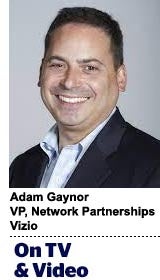“On TV And Video” is a column exploring opportunities and challenges in advanced TV and video.
Today’s column is written by Adam Gaynor, VP of Network Partnerships and Head of Addressable at VIZIO.
While we’ve been talking for years about using addressable to build a bridge between linear and connected TV, the seismic events of 2020 have given marketers and networks the motivation to finally get it done. Marketers will soon be able to better understand and connect with Hispanic America, an audience that is not one singular group but one made up of people from different countries, cultures and backgrounds.
I’m calling it now: 2021 will be the Year of Addressable transcends audiences and language.
Recently, Univision joined the Open Addressable Ready (OAR) consortium –a VIZIO-led initiative – where it will be a member of the Steering Committee, helping to establish a single addressable standard for the entire TV ecosystem. Univision is the first Spanish-language media company to sign on, marking a real commitment to serving its audience with relevant creative and expanding addressable TV advertising beyond just English-speaking Americans.
Not only is Univision the market leader for Spanish-language programming, the company has a long history of innovation – a history that continues with the addition of former Turner ad boss Donna Speciale to its management team as president of advertising sales and marketing. Speciale has long been an advanced TV trailblazer and a proponent of audience-based buying, as opposed to guarantees based solely on wide-ranging age and gender demographics.
Univision’s move is especially important because it’s also a significant step forward in expanding addressable’s diversity, equity, and inclusion capabilities.
The power of the Hispanic market
By now, just about everyone knows that the Hispanic market is underserved by traditional marketers. The purchasing power of this segment was $1.5 trillion in 2018, and will only continue to grow. The Hispanic population of the United States, at over 60 million in 2020, is set to reach 119 million by 2060.
Univision and its networks already provide advertisers with a highly targeted buy, reaching Hispanics in-language and in-culture. What this new initiative brings is the ability to further refine this targeting towards lifestyle and life stage i.e. Hispanic moms who are exercise fans, or Hispanic men who like the outdoors.
This way advertisers will be able to engage with individual life experiences which are as rich and varied as any English-speaking cohort, and they deserve to be treated as such by marketers. While many Spanish-dominant consumers share culture and traditions, there is opportunity to further refine targeting by factoring-in geographic location, lifestyle and life stage differences.
The Power of Addressable
Being able to serve these Spanish speakers creative that is relevant to them—creative that pairs language with specific cultural elements—is crucial to standing out in a crowded marketing environment. This specificity allows for a deeper connection between consumer and brand, assuring the consumer that they are truly understood.
Addressable advertising allows marketers to move away from broad categories like “language spoken,” just as they’re moving away from age and gender demography. If a marketer wants a Spanish-speaking viewer of a household to see an ad for a new soda flavor, that’s now possible.
By using the audience-based buying and delivery that addressable enables, marketers can reach both a mom who cares for her grandmother and the young mom in the market for a new Minivan in a way that won’t be perceived as insincere pandering. It’ll also help keep diverse Spanish-language programming on the air by providing brands with the opportunity to market to these diverse audiences they may not have otherwise thought of reaching.
Univision has four different linear networks with four different audiences – audiences that speak Spanish, yes, but with different creative needs.
Follow Adam Gaynor (@asgaynor01) and AdExchanger (@adexchanger) on Twitter.














